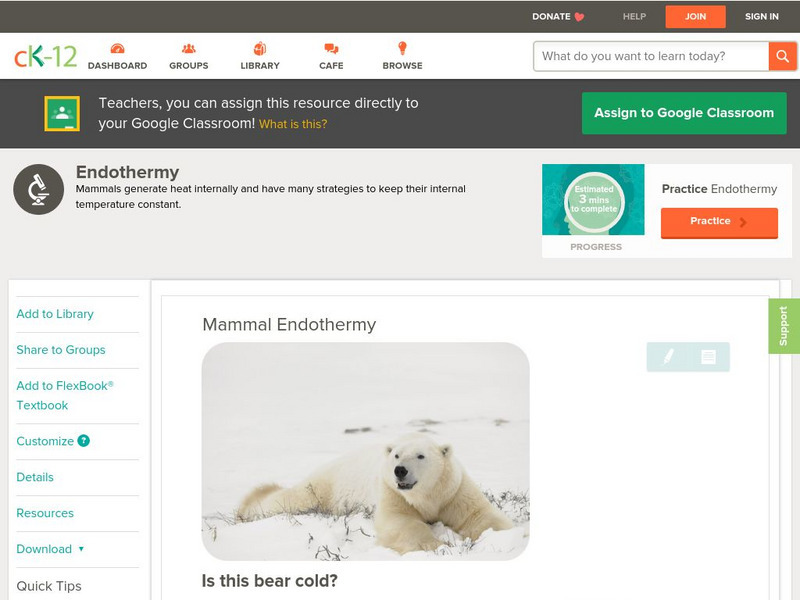Curated OER
Feedback and Flowcharts
Sixth graders explain what a negative feedback system is and they distinguish it from a positive feedback system. They describe examples of how negative feedback is used in both nature and technology. , Students define homeostasis, and...
Curated OER
Birds of Wisconsin
First graders explore the job done by ornithologists. They role play identifying the characteristics that make a bird a bird. They discuss what makes each bird species unique. Students are introduced to Wisconsin's most common and rare...
Georgia State University
Georgia State University: Hyper Physics: Temperature Regulation of the Human Body
Discusses the methods the human body uses to regulate body temperature. Includes links to the four external heat transfer mechanisms (radiation, conduction, convection, and evaporation of perspiration).
Other
Simple Science: Taking Temperatures
The innovative resource investigates endothermy and ectothermy. Students compare body temperature of a snake and rat before and after exposure under a heat lamp. The activity has an interactive online version and a printable data sheet.
Georgia State University
Georgia State University: Hyper Physics: Radiation Cooling of Body
Discusses the means by which the body regulates its temperature. The role of radiation in this process is explained. An equation for calculating the rate at which energy is transferred by radiation is presented. Also, an interactive...
PBS
Pbs Teachers: Scientific American: Worried Sick: Temperature and Stress
Explore the physiological effects of stress, and investigate the techniques of Tibetan monks to regulate their body temperature. Attach a thermistor to your fingertip to see if relaxation techniques can produce changes in body temperature.
Texas Instruments
Texas Instruments: Body Cooling Rate of Animals
Students make two models to stimulate the cooling rate of different skin surface areas. They use a Temperature Sensor to measure the cooling rate of the models. The students also compare the cooling rates of the models to determine the...
PBS
Pbs Learning Media: Fever!
This video describes the role of the brain in regulating body temperature and how sometimes fever is employed to fight off infection.
OpenStax
Open Stax: Anatomy & Physiology: Energy and Heat Balance
Learn how the human body regulates temperature and explain the significance of the metabolic rate.
CK-12 Foundation
Ck 12: Biology: Mammal Endothermy
[Free Registration/Login may be required to access all resource tools.] Describes how mammals maintain their body temperature.
CK-12 Foundation
Ck 12: Life Science: Homeostasis
[Free Registration/Login may be required to access all resource tools.] When you walk outside on a cool day, does your body temperature drop? No, your body temperature stays stable at around 98.6 degrees Fahrenheit. Even when the...
BBC
Bbc: Gcse Bitesize: Homeostasis in Humans
Homeostasis is the regulation of internal conditions inside cells or organisms, to create the optimum conditions for biological function, including body temperature. Links to a video and test are provided.
PBS
Pbs Teachers: Scientific American: Superhumans & Bionics: Mind Over Machine
Investigate a unique project that uses brain waves to operate machines, and perform biofeedback experiments to control physiological processes. Control hiccups and regulate your body temperature with your mind.
Curated OER
Smithsonian Institution Archives: Lillian Mary Moore (1887 1929)
Lillian Mary Moore (1887-1929) earned her Ph.D. from the department of physiology at the University of California, and then taught there from 1923 to 1929. Moore's research focused on regulation of body temperature













